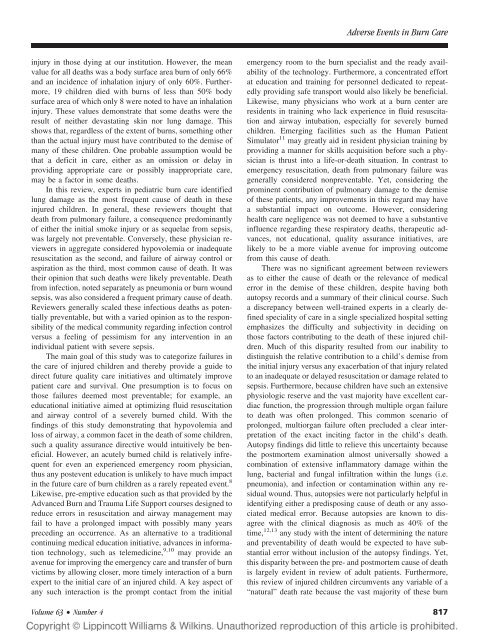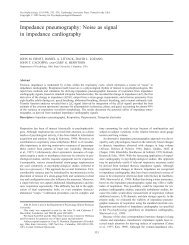Assessment of Adverse Events in the Demise of Pediatric Burn ...
Assessment of Adverse Events in the Demise of Pediatric Burn ...
Assessment of Adverse Events in the Demise of Pediatric Burn ...
Create successful ePaper yourself
Turn your PDF publications into a flip-book with our unique Google optimized e-Paper software.
<strong>Adverse</strong> <strong>Events</strong> <strong>in</strong> <strong>Burn</strong> Care<br />
<strong>in</strong>jury <strong>in</strong> those dy<strong>in</strong>g at our <strong>in</strong>stitution. However, <strong>the</strong> mean<br />
value for all deaths was a body surface area burn <strong>of</strong> only 66%<br />
and an <strong>in</strong>cidence <strong>of</strong> <strong>in</strong>halation <strong>in</strong>jury <strong>of</strong> only 60%. Fur<strong>the</strong>rmore,<br />
19 children died with burns <strong>of</strong> less than 50% body<br />
surface area <strong>of</strong> which only 8 were noted to have an <strong>in</strong>halation<br />
<strong>in</strong>jury. These values demonstrate that some deaths were <strong>the</strong><br />
result <strong>of</strong> nei<strong>the</strong>r devastat<strong>in</strong>g sk<strong>in</strong> nor lung damage. This<br />
shows that, regardless <strong>of</strong> <strong>the</strong> extent <strong>of</strong> burns, someth<strong>in</strong>g o<strong>the</strong>r<br />
than <strong>the</strong> actual <strong>in</strong>jury must have contributed to <strong>the</strong> demise <strong>of</strong><br />
many <strong>of</strong> <strong>the</strong>se children. One probable assumption would be<br />
that a deficit <strong>in</strong> care, ei<strong>the</strong>r as an omission or delay <strong>in</strong><br />
provid<strong>in</strong>g appropriate care or possibly <strong>in</strong>appropriate care,<br />
may be a factor <strong>in</strong> some deaths.<br />
In this review, experts <strong>in</strong> pediatric burn care identified<br />
lung damage as <strong>the</strong> most frequent cause <strong>of</strong> death <strong>in</strong> <strong>the</strong>se<br />
<strong>in</strong>jured children. In general, <strong>the</strong>se reviewers thought that<br />
death from pulmonary failure, a consequence predom<strong>in</strong>antly<br />
<strong>of</strong> ei<strong>the</strong>r <strong>the</strong> <strong>in</strong>itial smoke <strong>in</strong>jury or as sequelae from sepsis,<br />
was largely not preventable. Conversely, <strong>the</strong>se physician reviewers<br />
<strong>in</strong> aggregate considered hypovolemia or <strong>in</strong>adequate<br />
resuscitation as <strong>the</strong> second, and failure <strong>of</strong> airway control or<br />
aspiration as <strong>the</strong> third, most common cause <strong>of</strong> death. It was<br />
<strong>the</strong>ir op<strong>in</strong>ion that such deaths were likely preventable. Death<br />
from <strong>in</strong>fection, noted separately as pneumonia or burn wound<br />
sepsis, was also considered a frequent primary cause <strong>of</strong> death.<br />
Reviewers generally scaled <strong>the</strong>se <strong>in</strong>fectious deaths as potentially<br />
preventable, but with a varied op<strong>in</strong>ion as to <strong>the</strong> responsibility<br />
<strong>of</strong> <strong>the</strong> medical community regard<strong>in</strong>g <strong>in</strong>fection control<br />
versus a feel<strong>in</strong>g <strong>of</strong> pessimism for any <strong>in</strong>tervention <strong>in</strong> an<br />
<strong>in</strong>dividual patient with severe sepsis.<br />
The ma<strong>in</strong> goal <strong>of</strong> this study was to categorize failures <strong>in</strong><br />
<strong>the</strong> care <strong>of</strong> <strong>in</strong>jured children and <strong>the</strong>reby provide a guide to<br />
direct future quality care <strong>in</strong>itiatives and ultimately improve<br />
patient care and survival. One presumption is to focus on<br />
those failures deemed most preventable; for example, an<br />
educational <strong>in</strong>itiative aimed at optimiz<strong>in</strong>g fluid resuscitation<br />
and airway control <strong>of</strong> a severely burned child. With <strong>the</strong><br />
f<strong>in</strong>d<strong>in</strong>gs <strong>of</strong> this study demonstrat<strong>in</strong>g that hypovolemia and<br />
loss <strong>of</strong> airway, a common facet <strong>in</strong> <strong>the</strong> death <strong>of</strong> some children,<br />
such a quality assurance directive would <strong>in</strong>tuitively be beneficial.<br />
However, an acutely burned child is relatively <strong>in</strong>frequent<br />
for even an experienced emergency room physician,<br />
thus any postevent education is unlikely to have much impact<br />
<strong>in</strong> <strong>the</strong> future care <strong>of</strong> burn children as a rarely repeated event. 8<br />
Likewise, pre-emptive education such as that provided by <strong>the</strong><br />
Advanced <strong>Burn</strong> and Trauma Life Support courses designed to<br />
reduce errors <strong>in</strong> resuscitation and airway management may<br />
fail to have a prolonged impact with possibly many years<br />
preced<strong>in</strong>g an occurrence. As an alternative to a traditional<br />
cont<strong>in</strong>u<strong>in</strong>g medical education <strong>in</strong>itiative, advances <strong>in</strong> <strong>in</strong>formation<br />
technology, such as telemedic<strong>in</strong>e, 9,10 may provide an<br />
avenue for improv<strong>in</strong>g <strong>the</strong> emergency care and transfer <strong>of</strong> burn<br />
victims by allow<strong>in</strong>g closer, more timely <strong>in</strong>teraction <strong>of</strong> a burn<br />
expert to <strong>the</strong> <strong>in</strong>itial care <strong>of</strong> an <strong>in</strong>jured child. A key aspect <strong>of</strong><br />
any such <strong>in</strong>teraction is <strong>the</strong> prompt contact from <strong>the</strong> <strong>in</strong>itial<br />
emergency room to <strong>the</strong> burn specialist and <strong>the</strong> ready availability<br />
<strong>of</strong> <strong>the</strong> technology. Fur<strong>the</strong>rmore, a concentrated effort<br />
at education and tra<strong>in</strong><strong>in</strong>g for personnel dedicated to repeatedly<br />
provid<strong>in</strong>g safe transport would also likely be beneficial.<br />
Likewise, many physicians who work at a burn center are<br />
residents <strong>in</strong> tra<strong>in</strong><strong>in</strong>g who lack experience <strong>in</strong> fluid resuscitation<br />
and airway <strong>in</strong>tubation, especially for severely burned<br />
children. Emerg<strong>in</strong>g facilities such as <strong>the</strong> Human Patient<br />
Simulator 11 may greatly aid <strong>in</strong> resident physician tra<strong>in</strong><strong>in</strong>g by<br />
provid<strong>in</strong>g a manner for skills acquisition before such a physician<br />
is thrust <strong>in</strong>to a life-or-death situation. In contrast to<br />
emergency resuscitation, death from pulmonary failure was<br />
generally considered nonpreventable. Yet, consider<strong>in</strong>g <strong>the</strong><br />
prom<strong>in</strong>ent contribution <strong>of</strong> pulmonary damage to <strong>the</strong> demise<br />
<strong>of</strong> <strong>the</strong>se patients, any improvements <strong>in</strong> this regard may have<br />
a substantial impact on outcome. However, consider<strong>in</strong>g<br />
health care negligence was not deemed to have a substantive<br />
<strong>in</strong>fluence regard<strong>in</strong>g <strong>the</strong>se respiratory deaths, <strong>the</strong>rapeutic advances,<br />
not educational, quality assurance <strong>in</strong>itiatives, are<br />
likely to be a more viable avenue for improv<strong>in</strong>g outcome<br />
from this cause <strong>of</strong> death.<br />
There was no significant agreement between reviewers<br />
as to ei<strong>the</strong>r <strong>the</strong> cause <strong>of</strong> death or <strong>the</strong> relevance <strong>of</strong> medical<br />
error <strong>in</strong> <strong>the</strong> demise <strong>of</strong> <strong>the</strong>se children, despite hav<strong>in</strong>g both<br />
autopsy records and a summary <strong>of</strong> <strong>the</strong>ir cl<strong>in</strong>ical course. Such<br />
a discrepancy between well-tra<strong>in</strong>ed experts <strong>in</strong> a clearly def<strong>in</strong>ed<br />
speciality <strong>of</strong> care <strong>in</strong> a s<strong>in</strong>gle specialized hospital sett<strong>in</strong>g<br />
emphasizes <strong>the</strong> difficulty and subjectivity <strong>in</strong> decid<strong>in</strong>g on<br />
those factors contribut<strong>in</strong>g to <strong>the</strong> death <strong>of</strong> <strong>the</strong>se <strong>in</strong>jured children.<br />
Much <strong>of</strong> this disparity resulted from our <strong>in</strong>ability to<br />
dist<strong>in</strong>guish <strong>the</strong> relative contribution to a child’s demise from<br />
<strong>the</strong> <strong>in</strong>itial <strong>in</strong>jury versus any exacerbation <strong>of</strong> that <strong>in</strong>jury related<br />
to an <strong>in</strong>adequate or delayed resuscitation or damage related to<br />
sepsis. Fur<strong>the</strong>rmore, because children have such an extensive<br />
physiologic reserve and <strong>the</strong> vast majority have excellent cardiac<br />
function, <strong>the</strong> progression through multiple organ failure<br />
to death was <strong>of</strong>ten prolonged. This common scenario <strong>of</strong><br />
prolonged, multiorgan failure <strong>of</strong>ten precluded a clear <strong>in</strong>terpretation<br />
<strong>of</strong> <strong>the</strong> exact <strong>in</strong>cit<strong>in</strong>g factor <strong>in</strong> <strong>the</strong> child’s death.<br />
Autopsy f<strong>in</strong>d<strong>in</strong>gs did little to relieve this uncerta<strong>in</strong>ty because<br />
<strong>the</strong> postmortem exam<strong>in</strong>ation almost universally showed a<br />
comb<strong>in</strong>ation <strong>of</strong> extensive <strong>in</strong>flammatory damage with<strong>in</strong> <strong>the</strong><br />
lung, bacterial and fungal <strong>in</strong>filtration with<strong>in</strong> <strong>the</strong> lungs (i.e.<br />
pneumonia), and <strong>in</strong>fection or contam<strong>in</strong>ation with<strong>in</strong> any residual<br />
wound. Thus, autopsies were not particularly helpful <strong>in</strong><br />
identify<strong>in</strong>g ei<strong>the</strong>r a predispos<strong>in</strong>g cause <strong>of</strong> death or any associated<br />
medical error. Because autopsies are known to disagree<br />
with <strong>the</strong> cl<strong>in</strong>ical diagnosis as much as 40% <strong>of</strong> <strong>the</strong><br />
time, 12,13 any study with <strong>the</strong> <strong>in</strong>tent <strong>of</strong> determ<strong>in</strong><strong>in</strong>g <strong>the</strong> nature<br />
and preventability <strong>of</strong> death would be expected to have substantial<br />
error without <strong>in</strong>clusion <strong>of</strong> <strong>the</strong> autopsy f<strong>in</strong>d<strong>in</strong>gs. Yet,<br />
this disparity between <strong>the</strong> pre- and postmortem cause <strong>of</strong> death<br />
is largely evident <strong>in</strong> review <strong>of</strong> adult patients. Fur<strong>the</strong>rmore,<br />
this review <strong>of</strong> <strong>in</strong>jured children circumvents any variable <strong>of</strong> a<br />
“natural” death rate because <strong>the</strong> vast majority <strong>of</strong> <strong>the</strong>se burn<br />
Volume 63 • Number 4 817



